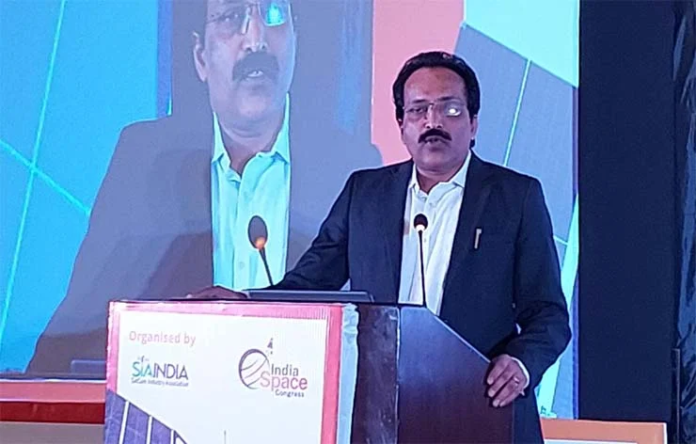New Delhi: Indian Space Research Organisation (ISRO) Chairman S Somanath during his keynote address at the third annual India Space Congress (ISC) 2024 held in New Delhi said that India’s space sector is at a critical juncture, facing both challenges and opportunities.
Highlighting the need to stimulate internal demand for satellite launches within India, ISRO Chairman emphasised that while ISRO has developed significant space capabilities and nurtured talent in the country, creating robust demand remains a crucial objective. “We need to create more internal demand,” stated Somanath, pointing out that the communication segment and big satellite builders could drive this demand through expanded applications of satellite technology.
Somanath noted that despite global trends have reduced the cost of accessing space, particularly due to innovations by companies like SpaceX, India’s rocket costs have not seen similar reductions. Lowering these costs is essential to enable more frequent and cost-effective launches, thereby attracting new participants and fostering growth in the sector. He acknowledged the willingness of major companies to invest in India’s space sector but highlighted their concerns regarding profitability and securing orders. He stressed the importance of addressing these concerns to encourage significant investments in large-scale state projects, crucial for expanding India’s space operations.
Discussing technological advancements, Somanath stated that the long-term goal is to land on the moon by 2040, marking a significant leap in India’s space exploration capabilities. However, Somanath admitted current limitations in India’s rocket capabilities, notably with GSLV MKIII (LVM3), which lacks sufficient payload capacity for round trips to the moon. Developing higher-capacity rockets is essential for future lunar missions, including the ability to retrieve samples and eventually conduct manned missions.
ISRO Chairman S Somanath, highlighting immediate plans, announced the forthcoming launch of GSAT-20, a high-throughput Ka-band satellite designed to enhance connectivity with over 50 Gbps bandwidth capacity. Scheduled to launch aboard Falcon 9 in mid-August, GSAT-20 represents India’s commitment to leveraging advanced satellite technology for broader societal benefits. The space agency is also gearing up for three tests of Gaganyaan this year, including the first unmanned mission, second test vehicle mission (TV-DO2) and first pad-abort test to be completed by December-end.
After demonstrating a successful moon landing near its south pole, the Indian Space Research Organisation (ISRO) is preparing for Chandrayaan-4 to collect and bring back samples from the lunar surface. The mission will involve multiple launches, and the premier space agency is set to perform a space docking experiment later this year to develop its capabilities for the challenging endeavour. The test called SPADEX – Space Docking Experiment — involves two mini-satellites which will be injected into two different orbits. The task is to bring them closer enough to join them to be able to transfer objects in space. This capability is essential for future manned missions as well as for bringing back samples.
For future space missions including human spaceflights, the docking capability is crucial. ISRO is keen to continue with its Chandrayaan series of missions to further explore the moon until it develops the capability to successfully land its astronauts on the lunar surface. The space agency plans to launch the SPADEX by November-December this year, but is yet to finalise a date.
On the sidelines of the India Space Congress in New Delhi, Somanath said, “We have worked out the configuration of Chandrayaan-4 and how to bring samples from the moon to earth. The entire project report with studies, review and cost has been worked out and sent for approval. We have proposed multiple launches because our current rocket capability is not enough for us to go in one mission, and return. So we need to develop docking capability in both earth-space and moon space systems. We are developing that capability.” .
ISRO also has its eyes set on Gaganyaan to fulfil India’s long-standing dream of sending astronauts into space. After the successful completion of the first Test Vehicle (TV-D1) last October, it is now preparing to perform three subsequent tests this year. “We have three tasks ahead this year. One is called the G-1 – the first unmanned mission of Gaganyaan with LVM-3 followed by a second test vehicle demonstration (TV-D2) and then the first pad abort test. We are working on all three tests parallelly, and we are hopeful that by December all three can be completed,” said the ISRO chief on June 26.
With multiple missions in the pipeline, the space agency has its hands full this year. The joint Indo-US space mission – NISAR (NASA-ISRO Synthetic Aperture Radar) — jointly developed by scientists from the United States and India is also set for launch. The powerful satellite will map the entire earth every 12 days with high precision and resolution, and capture places that have otherwise been obscured. The mission was expected to launch early this year, but got delayed after one of the components had to be sent back to the US for some corrections. According to the ISRO chief, the satellite is likely to be ready by September-end.
He added, “One part of the payload – a deployable antenna which is a US-company supply right. So we have sent it back to the company in the US. They have to do some corrections, and it is likely to be brought back by 10th July. Once it reaches here, it has to be integrated with the satellite, and go through the entire testing process. The process is likely to take another two months. Once the satellite is ready, then we have to see if the GSLV is available for launch, so we will have to prioritize the missions accordingly.”





